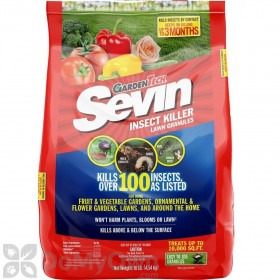Insecticide For New Sod
-
Pesticides are often harsh on your grass and environmentally unfriendly, so restricting the use of them unless your grass desperately needs their help is the best strategy. The University of California’s Integrated Pest Management program suggests only using pesticides if you encounter the following number of pests within a given area: five armyworms or cutworms per square yard, one billbug or its larvae per square foot, 40 black turfgrass ataenius or their larvae per square foot, six white grubs per square foot, 15 lawn moths or their larvae per square yard and 135 southern chinch bugs per square yard. Unless the presence of firefly skippers exceeds 15 per square yard, and they’re damaging your yard — via chewing the grass and creating small splotches of browning grass — there’s no need to implement control methods to counter them. One square yard is nine square feet, so check your yard in multiple locations for the pests.
Insecticides
-
Bacillus thuringiensis, imidacloprid, azadirachtin and pyrethrin serve as the four primary insecticides effective against sod pests. Bacillus thuringiensis is by far the least harmful, but only works against armyworms and cutworms. When applied to the soil, the pests eat the bacterium and die within days. It’s very effective against young armyworms and cutworms, but less so against mature ones. Azadirachtin is the second safest and kills armyworms, cutworms and lawn moth larvae. It’s somewhat toxic to bees and harmful to aquatic life if washed into waterways. It serves as a growth disruptor, killing affected pests within a week. Pyrethrin is the second most harmful insecticide on the list, but kills southern chinch bugs, armyworms, cutworms, fiery skippers and lawn moths. It’s somewhat toxic to honeybees and highly toxic to aquatic life. Imidacloprid takes the crown as the most toxic insecticide on the list, as it’s extremely dangerous to both bees and natural predators of various insects. It slowly kills pests by first paralyzing them. White grubs, black turfgrass ataenius larvae and billbugs all fall victim to the insecticide. In addition to insecticides, parasitic nematodes also take care of many harmful pests.
Insecticide For New Sod
Newly laid sod is susceptible to insect damage and needs extra care to ensure that it remains healthy. Insecticide for new sod is a concentrated solution that you apply directly to the grass to protect it from pests. It’s designed to be used at the beginning of the growing season, when your lawn is most vulnerable.
Insecticide for new sod comes in two different types: systemic and contact. Systemic insecticides are absorbed by the roots and travel up through the plant, killing insects on their way up. They’re effective against a wide range of pests, but they can take some time to work—three weeks or more—and may not be effective against some species, such as Japanese beetle larvae (which eat root tips). Contact insecticides kill insects right away, but don’t offer any protection for future generations of bugs—if you use this type of product, you’ll need to reapply it periodically throughout the summer as needed.
If you’re looking for an insecticide that’s been especially formulated for use on new sod during its vulnerable first weeks as a lawn, look for products with active ingredients like acephate or carbaryl—these are synthetic pyrethroids that work well against many common turf-damaging insects such as chinch bugs and mole cricket.
List Of Insecticide For New Sod
Additional Info :
- Kills mosquitoes before they’re old enough to bite
- The only product with bti, bacteria toxic only to mosquito larvae
- Lasts for 30 days and treats 100 square feet of surface water
- Non-toxic to all other wildlife , pets, fish, and humans
- Labeled for organic gardening by the usepa
Additional Info :
| Color | Natural |
| Item Dimensions | |
| Height | 12 Inches |
| Width | 0.8 Inches |
| Length | 5.5 Inches |
| Weight | 0.2425084882 Pounds |
| Release Date | 2011-06-03T00:00:01Z |
- FOR ORGANIC GARDENING: Can be used up to day of harvest – OMRI (Organic Materials Review Institute) Listed.
- INSECTICIDE/FUNGICIDE/MITICIDE: Three garden products in one!
- READY-TO-USE SPRAY: Spray for complete coverage of all plant tissue.
- FOR USE ON: Roses, flowers, houseplants, ornamental trees and shrubs, fruits and vegetables.
- PREVENTS LISTED FUNGAL DISEASES: Apply weekly to every 2 weeks until the potential for disease is no longer present.
Additional Info :
| Item Dimensions | |
| Height | 0.88 Inches |
| Width | 0.21 Inches |
| Length | 0.37 Inches |
| Weight | 1 Pounds |





